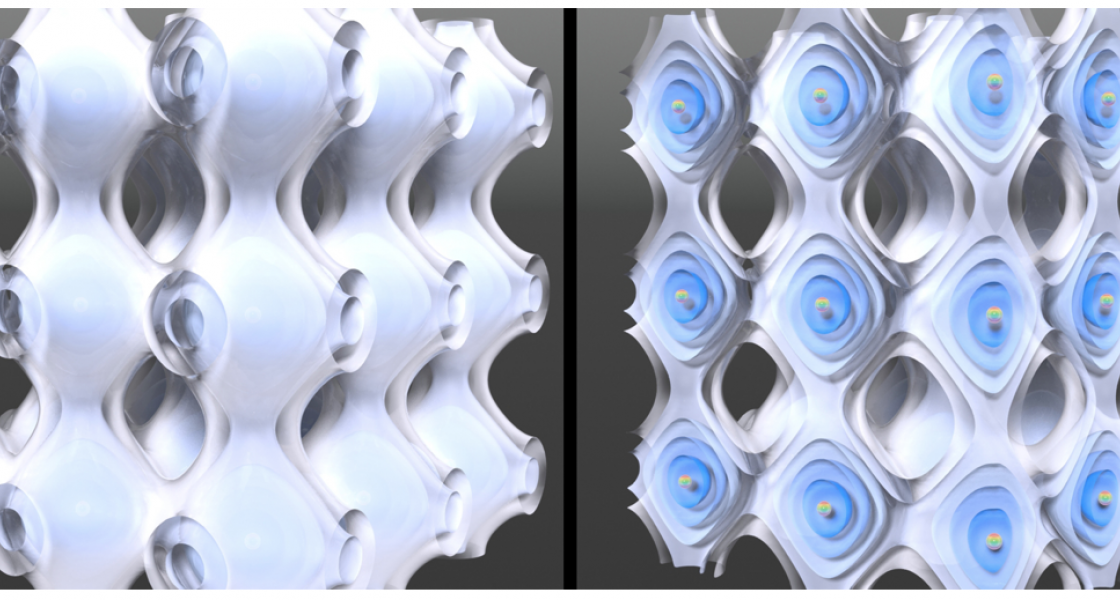News Flash! The Rey group has discovered another good reason for using alkaline-earth atoms, such as strontium (Sr) or Ytterbium (Yb), in experimental quantum simulators. Quantum simulators are systems that mimic interesting materials or mathematical models in a very controlled way. The new reason for using alkaline earth atoms in such systems comes from the fact that their nuclei come in as many as 10 different magnetic flavors, i.e., their spins can be in 10 different quantum states.
When people normally think about magnetism, they often think of the two most common magnetic flavors: spin up and spin down. And, when the spins of billions and billions of iron atoms all line up in one of these two directions, the result is the familiar bar magnet.
But things are never so simple and straightforward in the quantum world. It’s as if in addition to spin up and spin down in alkaline earth atoms, there were also eight more unique spin directions such as spin forwards, spin backwards, or spin diagonal. (Of course, in this case, the spin directions are just a convenient analogy for quantum spin states.)
The multi-flavored alkaline earth atoms have some real advantages in quantum simulation. Inside a simulator, a set number of alkaline-earth atoms with ten flavors can actually make the whole system get five times colder than the same number of atoms with only two flavors. This result was entirely unexpected.
Conventional wisdom said that a higher number of magnetic flavors in the atomic nuclei would cause the lowest-possible temperature of the system to be higher than that of a system with a lower number of magnetic flavors!
“I was so shocked when we first saw this, I spent a whole day trying to find the error in my calculation,” said Kaden Hazzard, an NRC (National Research Council) postdoc with the Rey group. But, Hazzard hadn’t made a mistake. The Rey group has proved conventional wisdom wrong — and opened the door to some novel experiments with the quantum simulator in the Ye lab.
Since the simulator is already kept at ultracold temperatures, the newly discovered relationship of cooling to an increased number of spin states means that it should theoretically be possible to cool highly controlled atoms down to nano-Kelvin temperatures. Such temperatures are needed to directly observe quantum magnetism in action.
“When you get alkaline earth atoms really cold, that’s when you can see the most interesting physics,” Hazzard said.
Because of the unique properties of alkaline earth atoms, scientists will soon be able to study what happens when different magnetic flavors interact and produce spin ordering. For instance, as a simulator gets colder, random flavors may take on their preferred spin direction at regular intervals inside a three-dimensional lattice, like the one shown in Figure 1.
This behavior will set the stage for the creation of antiferromagnets and spin liquids. In antiferromagnets, random magnetic flavors assume their preferred directions at utralow temperatures of below 1 nK. Spin liquids can occur when interactions or geometrical factors frustrate the antiferromagnetic order, causing it to “ melt.” In the resulting spin liquid, spins can fluctuate through different states even near a temperature of absolute zero.
Antiferromagnets and spin liquids have not yet been observed in the laboratory. But, the Rey group’s predictions give hope that they soon may be seen soon in simulators using alkaline earth atoms.
The work on the new flavors of quantum magnetism was done by Hazzard, Fellow Ana Maria Rey, and their colleagues Victor Gurarie and Michael Hermele from the University of Colorado. Research associates Salvatore Manmana and Gang Chen as well as colleague Adrian Feiguin of the University of Wyoming worked with Hazzard and Rey on foundational work for the new theory. The Rey group is continuing its investigations of quantum magnetism with colleagues in Germany and Austria.



 The Physics Frontiers Centers (PFC) program supports university-based centers and institutes where the collective efforts of a larger group of individuals can enable transformational advances in the most promising research areas. The program is designed to foster major breakthroughs at the intellectual frontiers of physics by providing needed resources such as combinations of talents, skills, disciplines, and/or specialized infrastructure, not usually available to individual investigators or small groups, in an environment in which the collective efforts of the larger group can be shown to be seminal to promoting significant progress in the science and the education of students. PFCs also include creative, substantive activities aimed at enhancing education, broadening participation of traditionally underrepresented groups, and outreach to the scientific community and general public.
The Physics Frontiers Centers (PFC) program supports university-based centers and institutes where the collective efforts of a larger group of individuals can enable transformational advances in the most promising research areas. The program is designed to foster major breakthroughs at the intellectual frontiers of physics by providing needed resources such as combinations of talents, skills, disciplines, and/or specialized infrastructure, not usually available to individual investigators or small groups, in an environment in which the collective efforts of the larger group can be shown to be seminal to promoting significant progress in the science and the education of students. PFCs also include creative, substantive activities aimed at enhancing education, broadening participation of traditionally underrepresented groups, and outreach to the scientific community and general public.